Suwari-Waza Shomen-uchi Dai-Ikkyo
(or Ude-osae)
Demonstrated and explained by Kanetsuka Sensei
|
|

Photos and text: Peter Megann
Graphics and typesetting: Graham and Laura Jones
Uke: Richard Martin
|
Dai Ikkyo ('Number One Study') or Ude-Osae ('Arm Pin') is one of the most important techniques in Aikido. "It is said that in Aikido you hardly need learn other techniques if you can master it" (Aikido by Kisshomaru Ueshiba). It is the basis of all pinning techniques (katame-waza) and the essence of the technique lies in turning your partner's elbow over. From Dai Ikkyo proceed the other important pinning techniques: Dai-Nikyo, Dai-Sankyo, Dai-Yonkyo and Dai-Gokyo. Essentially, with Ikkyo you control the attacker through his arm.
1. Omote
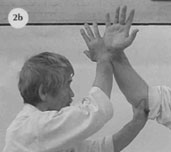 Photos 1, 2a & 2b: Anticipating an attack from Uke, Tori initiates an attack with shomen-
uchi. the fingers pointing upwards: the hand is not pushing. The purpose of this is to provoke Uke to block in order to protect himself and so enable Tori to grasp under Uke's elbow with his left hand. Note that Tori rises onto his toes (kiza) as he makes the blow. This means that his centre rises so that he is not pushing Uke's arm up with his hands. He makes contact with Uke's right forearm with his right hand-blade (te-gatana). Do not grasp Uke's wrist at this point. At the same time Tori's left hand cups Uke's arm just above the elbow, the thumb making good contact on the inside of the arm. In this way it is easy to turn Uke's elbow over.
Photos 1, 2a & 2b: Anticipating an attack from Uke, Tori initiates an attack with shomen-
uchi. the fingers pointing upwards: the hand is not pushing. The purpose of this is to provoke Uke to block in order to protect himself and so enable Tori to grasp under Uke's elbow with his left hand. Note that Tori rises onto his toes (kiza) as he makes the blow. This means that his centre rises so that he is not pushing Uke's arm up with his hands. He makes contact with Uke's right forearm with his right hand-blade (te-gatana). Do not grasp Uke's wrist at this point. At the same time Tori's left hand cups Uke's arm just above the elbow, the thumb making good contact on the inside of the arm. In this way it is easy to turn Uke's elbow over.
While making this first contact Tori is already turning his body to his right, his weight beginning to shift onto his right knee. In other words, he is already deflecting Uke's body from the first contact, rather than pushing him backwards.
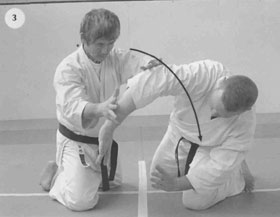 Photo 3: Tori slides his right knee diagonally to the side. At the same time he cuts down in a circular movement with his right te-gatana and rolls Uke's elbow over with his left hand. The two hands should be working in unison. The movement of Tori's centre is what dictates this action: there should be no pushing or thrusting. Tori is essentially in hanmi now. His overall posture is triangular, like a pyramid. This is a pivotal point of the technique. From this stage you can execute the omote forms of ikkyo, nikyo, sankyo and yonkyo. Gokyo too is possible, though it needs a change of grip at the stage of Photo 2.
Photo 3: Tori slides his right knee diagonally to the side. At the same time he cuts down in a circular movement with his right te-gatana and rolls Uke's elbow over with his left hand. The two hands should be working in unison. The movement of Tori's centre is what dictates this action: there should be no pushing or thrusting. Tori is essentially in hanmi now. His overall posture is triangular, like a pyramid. This is a pivotal point of the technique. From this stage you can execute the omote forms of ikkyo, nikyo, sankyo and yonkyo. Gokyo too is possible, though it needs a change of grip at the stage of Photo 2.
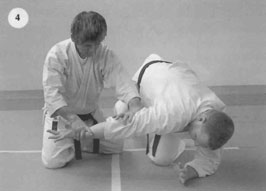 Photo 4: The formation of the body and arms is similar to that at the end of kokyu-ho. Tori has now grasped Uke's right wrist. Don't turn your wrist over: you should be maintaining contact with the heel of your hand, your little finger and your ring finger - the fingers gripping lightly. The index fingers of both hands are pointing inwards. Tori's grip on Uke's elbow is identical. The grip with the hand should not be regarded as independent of the rest of the arm. Shoulder, elbow and wrist are all involved; and the position of the elbow is very important. Think of the grip as a sankyo grip. There should be no pushing at this point: more a matter of deflecting Uke's body. You should be quite relaxed - like holding a large balloon.
Photo 4: The formation of the body and arms is similar to that at the end of kokyu-ho. Tori has now grasped Uke's right wrist. Don't turn your wrist over: you should be maintaining contact with the heel of your hand, your little finger and your ring finger - the fingers gripping lightly. The index fingers of both hands are pointing inwards. Tori's grip on Uke's elbow is identical. The grip with the hand should not be regarded as independent of the rest of the arm. Shoulder, elbow and wrist are all involved; and the position of the elbow is very important. Think of the grip as a sankyo grip. There should be no pushing at this point: more a matter of deflecting Uke's body. You should be quite relaxed - like holding a large balloon.
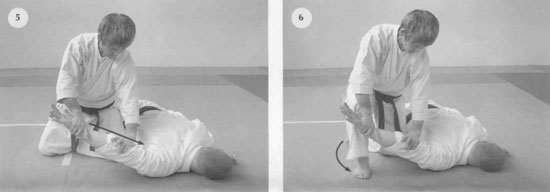 |
Photo 5: Pivoting on his right knee Tori advances his left hip and slides his left knee forwards towards Uke's right armpit. He moves with shikko, keeping his heels together. The action on Uke's arm is like thrusting with yari (spear) towards Uke's right armpit. |
|
Photo 6: Tori swings his right hip and knee forwards, pivoting on his left knee. In this instance Tori raises his right knee because of the disparity of size with his partner, who is much bigger (it is difficult to cover the distance simply with normal shikko movement). In other circumstances Tori could simply slide his right knee forward. |
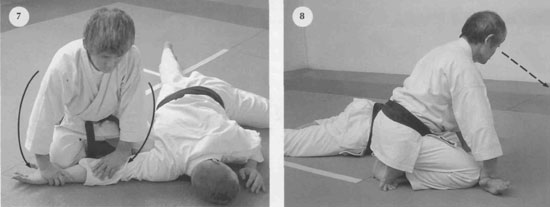
Photos 7-8: In the final pin Tori opens his knees so that his left knee is expanding towards Uke's armpit and his right knee comes to Tori's wrist. It is important that Uke's arm is brought to rather more than 90° to his body. Tori is now sitting up on his toes (kiza) putting his weight on his heels (the role of the toes is important at this point), his tanden is thrust forward and his spine is slightly concave (don't hunch the back). Tori's feet and two knees form a triangle, like a tripod. His right knee is inside his gripping hand, as though locking it. Tori is stretching Uke's arm, pinning the inside of Uke's elbow to the tatami. Breathing out, he finally brings his weight to bear on the ligament just above Uke's elbow. His energy is flowing down his left arm towards his fingertips. He is looking forwards to a point about two metres in front.
2. Ura
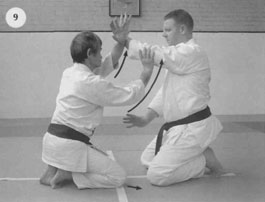 Photo 9: In this situation Uke has begun the action by making shomen-uchi. Tori rises onto his toes, slides his right knee forward and intercepts Uke's attack by swinging his hands up to protect his head. His elbows are expanding and the feeling is like that of an umbrella opening. As Tori's left forearm meets Uke's forearm with te-gatana and is ready to twist and deflect Uke's power to the left, his right hand grasps Uke's upper arm (just above the elbow). The 'cupping' formation of this hand is the same as at the beginning of the 'omote' response in Photo 1. This is not a blocking but a deflecting action. Be careful not to push.
Photo 9: In this situation Uke has begun the action by making shomen-uchi. Tori rises onto his toes, slides his right knee forward and intercepts Uke's attack by swinging his hands up to protect his head. His elbows are expanding and the feeling is like that of an umbrella opening. As Tori's left forearm meets Uke's forearm with te-gatana and is ready to twist and deflect Uke's power to the left, his right hand grasps Uke's upper arm (just above the elbow). The 'cupping' formation of this hand is the same as at the beginning of the 'omote' response in Photo 1. This is not a blocking but a deflecting action. Be careful not to push.
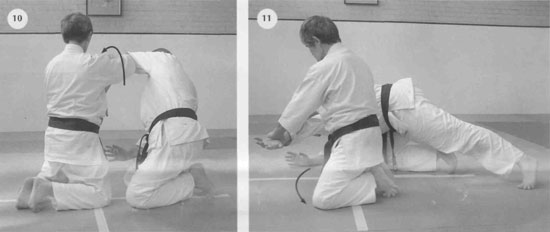
Photos 10 & 11: Tori slides his right knee forward slightly and starts to turn Uke's elbow over, rising up from his toes so as to advance his centre. But at the same time Tori is turning to his left, pivoting on his right knee, so the thrust of his movement is not forwards but slightly to the side. Compare the action of the hands with that in suwari-waza kokyu-ho, the left hand going down and the right one going up, with the body turning to follow. The left knee is drawn backwards but this does not mean that Tori's centre is moving backwards. His centre remains always in the centre of the movement: Uke's elbow is always in front of Tori's centre. Do not turn away from your partner and leave his body behind, otherwise you will have to drag your partner round. The line of the arms should correspond with that of the hips during the whole turn. The bodies of Tori and Uke must move in unison.
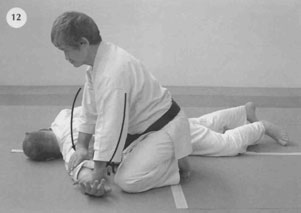 Photo 12: Tori continues to pivot on his right knee until, drawing his right hip round, he finishes at right angles to the original line. The pin is the same as in Photos 7 & 8.
Photo 12: Tori continues to pivot on his right knee until, drawing his right hip round, he finishes at right angles to the original line. The pin is the same as in Photos 7 & 8.

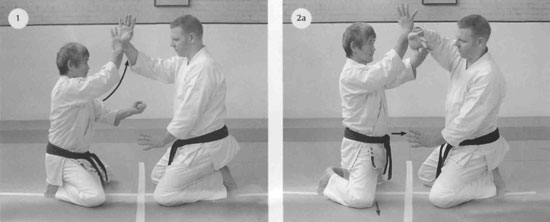


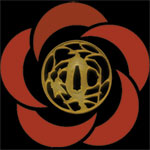

 Photos 1, 2a & 2b: Anticipating an attack from
Photos 1, 2a & 2b: Anticipating an attack from  Photo 3:
Photo 3:  Photo 4: The formation of the body and arms is similar to that at the end of
Photo 4: The formation of the body and arms is similar to that at the end of 
 Photo 9: In this situation
Photo 9: In this situation  Photo 12:
Photo 12: